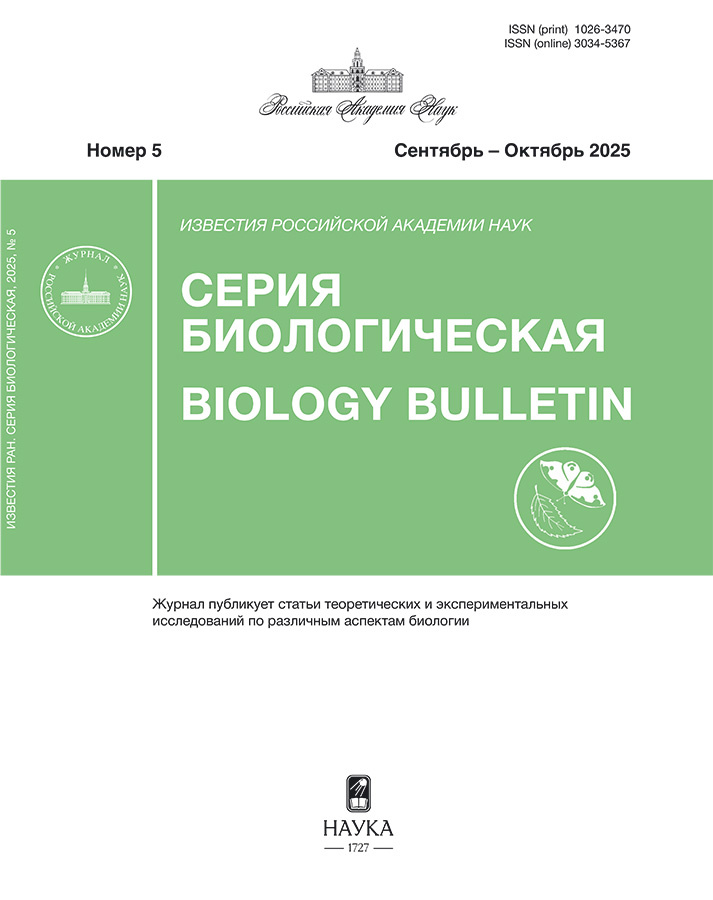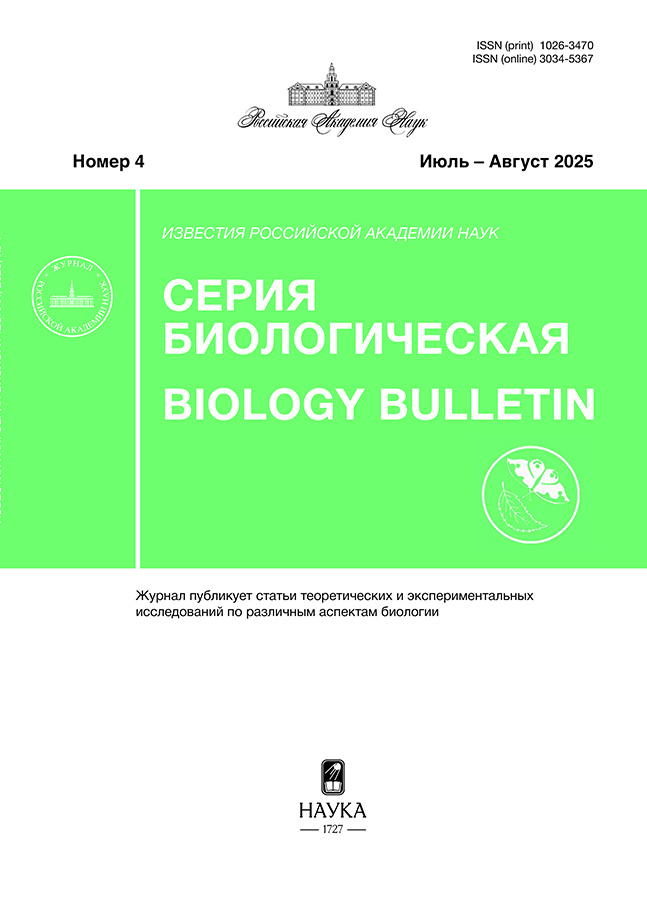Направленная асимметрия у коловратки Keratella Quadrata Müller, 1786
- Авторы: Тюлин Д.Ю.1, Никитенко А.И.1, Жернаков И.А.1, Васильев А.А.2, Гусева Ю.А.2
-
Учреждения:
- Филиал по пресноводному рыбному хозяйству ФГБНУ ВНИРО
- ФГБОУ ВО МГАВМиБ – МВА имени К.И. Скрябина
- Выпуск: № 4 (2025)
- Страницы: 430–442
- Раздел: ЭКОЛОГИЯ
- URL: https://vietnamjournal.ru/1026-3470/article/view/687634
- DOI: https://doi.org/10.31857/S1026347025040073
- ID: 687634
Цитировать
Полный текст
Аннотация
На основании материалов научного мониторинга на пресноводных водоемах Центральной части Российской Федерации в 2023–2024 гг. впервые показана направленная асимметрия у Keratella quadrata. Для популяций со всех станций характерна направленная асимметрия: особи с более длинным левым шипом присутствуют во всех выборках, но всегда составляют менее половины выборки (от 2 до 40%). Величина магнитного поля Земли и географическая широта умеренно коррелируют с разницей между максимальной и минимальной величиной асимметрии длины шипов. Более слабые обратные умеренные корреляции наблюдаются между процентом особей с более длинным левым шипом и такими показателями, как географическая широта и суммарная биомасса хищников рода Asplanchna и отряда Cyclopoida. При этом средняя длина шипов умеренно коррелирует с биомассой рачков отряда Cyclopoida в воде, из которой были изъяты коловратки K. quadrata.
Ключевые слова
Полный текст
Об авторах
Д. Ю. Тюлин
Филиал по пресноводному рыбному хозяйству ФГБНУ ВНИРО
Email: alexey_nikitenko90@mail.ru
Россия, 40а, пос. Рыбное, Дмитровский р-н, Московская область, 141821
А. И. Никитенко
Филиал по пресноводному рыбному хозяйству ФГБНУ ВНИРО
Автор, ответственный за переписку.
Email: alexey_nikitenko90@mail.ru
Россия, 40а, пос. Рыбное, Дмитровский р-н, Московская область, 141821
И. А. Жернаков
Филиал по пресноводному рыбному хозяйству ФГБНУ ВНИРО
Email: alexey_nikitenko90@mail.ru
Россия, 40а, пос. Рыбное, Дмитровский р-н, Московская область, 141821
А. А. Васильев
ФГБОУ ВО МГАВМиБ – МВА имени К.И. Скрябина
Email: alexey_nikitenko90@mail.ru
Россия, улица Академика Скрябина 23, Москва, 109472
Ю. А. Гусева
ФГБОУ ВО МГАВМиБ – МВА имени К.И. Скрябина
Email: alexey_nikitenko90@mail.ru
Россия, улица Академика Скрябина 23, Москва, 109472
Список литературы
- Винберг Г. Г., Лаврентьева Г. М. Методические рекомендации по сбору и обработке материалов при гидробиологических исследованиях на пресноводных водоемах // Зоопланктон и его продукция. Л.: ГосНИОРХ, 1982. 33 с.
- Котеров А. Н., Ушенкова Л. Н., Зубенкова Э. С., Калинина М. В., Бирюков А. П., Ласточкина Е. М., Молодцова Д. В., Вайнсон А. А. Сила связи. Сообщение 2. Градации величины корреляции // Медицинская радиология и радиационная безопасность. 2019. Т. 64. № 6. С. 12–24.
- Кутикова Л. А. Коловратки фауны СССР (Rotatoria). Подкласс Eurotatoria. Отряды Ploimida, Monimotrochida, Paedotrochida // Л.: Наука, 1970. 744 с.
- Кутикова Л. А., Стойко Т. Г., Мазей Ю. А., Телеш И. В. Определитель зоопланктона и зообентоса пресных вод Европейской России. Под редакцией Алексеева В. Р., Цалолихина, С. Я. Зоопланктон. 2010. Т. 1. М.; СПб.: КМК, 495 с.
- Babcock L. E. Trilobite malformations and the fossil record of behavioral asymmetry // Journal of Paleontology, 1993. V. 3. P. 217–229.
- Conde-Porcuna J.M., Declerck S. Regulation of rotifer species by invertebrate predators in a hypertrophic lake: Selective predation on egg-bearing females and induction of morphological defences // Journal of Plankton Research, 1998. V. 20. №4. P. 605–618. https://doi.org/10.1093/plankt/20.4.605
- Ge Ya-Li, Yu Xiao-Jing, Zhan R., Yu Jin-Hang, Xi Yi-Long, Zhang G. Comparison of life-history parameters and effectiveness in competition with Moina macrocopa between two Keratella tropica morphs // Limnologica, 2020. 85:125823. https://doi.org/10.1016/j.limno.2020.125823
- Ge Ya-Li, Zhan R., Yu Jin-Hang, Xi Yi-Long, Ma J., Xu Dan-Dan. Effects of food concentration on the life table demography and morphology of three Keratella quadrata morphotypes // Annales de Limnologie - International Journal of Limnology, 2018. 54:16. https://doi.org/10.1051/limn/2018006
- Gilbert J. J. Non-genetic polymorphisms in rotifers: environmental and endogenous controls, development, and features for predictable or unpredictable environments // Biological Reviews, 2017. V. 92(2): P. 964–992. https://doi.org/10.1111/brv.12264
- Gilbert J. J. Predator-specific inducible defenses in the rotifer Keratella tropica // Freshwater Biology, 2009. V. 54: P. 1933–1946.
- Gilbert J. J. The cost of predator-induced morphological defense in rotifers: experimental studies and synthesis // Journal of Plankton Research. 2013. V. 35 (3): P. 461–472.https://doi.org/10.1093/plankt/fbt017
- Gilbert J. J., Stemberger R. S. Asplanchna-induced polymorphism in the rotifer Keratella slacki // Limnology and Oceanography, 1984. V. 29 (6). P. 1309–l316.
- Hori M., Takahashi S. Lateral Asymmetry in Animals. Predator-Prey Interactions, Dynamics, and Evolution // Springer Nature Singapore Pte Ltd, 2022. V. 295 P.https://doi.org/10.1007/978-981-19-1342-6
- Hoso M., Kameda Y., Wu S.-P., Asami T., Kato M., Hori M. A speciation gene for left–right reversal in snails results in anti-predator adaptation // Nature communications, 2010. 1:133.https://doi.org/10.1038/ncomms1133
- Inoda T., Hirata Y. and Kamimura S. Asymmetric Mandibles of Water‐Scavenger Larvae Improve Feeding Effectiveness on Right‐Handed Snails // The American Naturalist, 2003. V. 162 (6): P. 811–814.https://doi.org/10.1086/378903
- Jozet-Alves C., Romagny S., Bellanger C., Dickel L. Cerebral correlates of visual lateralization in Sepia. Behav Brain Res. 2012 Sep 1; V. 234 (1):20-5. Epub 2012 Jun 4. PMID: 22677275.https://doi.org/10.1016/j.bbr.2012.05.042
- Krylov V. V., Bolotovskaya I. V., Osipova E. A. Theresponse of European Daphnia magna Straus and Australian Daphnia carinata King to changes in geomagnetic field // Electromagnetic Biology and Medicine, 2012. V. 32 (1): P. 30–39.
- Nadira S., Salah A., Saber B., Touati H., Mourad B. The effect of environmental factors on rotifers abundance in Oubeira Lake (North East of Algeria) // International Journal of Biosciences, 2018. V. 12 (4): P. 158–171.https://doi.org/10.12692/ijb/12.2.158-171
- Pan L., Zhu H., Wang Y., Shi Bao-Chun, Cheng Xin-Feng, Ge Ya-Li, Xiang Xian-Ling, Wen Xin-Li, Xi Yi-Long. Adaptation of a prey population to increasing predation risks // Hydrobiologia, 2023. V. 851. P. 3097–3107.https://doi.org/10.1007/s10750-023-05369-2
- Pélabon C., Hansen T. F. On the adaptive accuracy of directional asymmetry in insect wing size. Evolution. 2008 Nov; V. 62(11):2855-67. Epub 2008 Aug 26. PMID: 18752614.https://doi.org/10.1111/j.1558-5646.2008.00495.x
- Ren J., Mo W., Zhang H., He R., Wang X., Jiang T., Liu Y. The light-independent locomotion response to a static magnetic field in Xenopus // Frontiers in Physics, 2022. V. 10: P. 1–10.https://doi.org/10.3389/fphy.2022.995860
- Roberts D. C., Marcelli V., Gillen J. S., Carey J. P., Della Santina C. C., Zee D. S. MRI Magnetic Field Stimulates Rotational Sensors of the Brain // Current Biology, 2016. V. 21 (19): P. 1635–1640.https://doi.org/10.1016/j.cub.2011.08.029
- Signore I. A., Palma K., Concha M. L. Nodal signalling and asymmetry of the nervous system // Philosophical Transactions of the Royal Society B, 2016. V. 371 (1710): 20150401.https://doi.org/10.1098/rstb.2015.0401
- Stemberger R. S., Gilbert J. J. Multiple-species induction of morphological defenses in the rotifer Keratella testudo // Ecology, 1987. V. 68 (2). P. 370–378.
- Tasevska O., Jersabek C. D., Kostoski1 G., Gušeska D. Differences in rotifer communities in two freshwater bodies of different trophic degree (Lake Ohrid and Lake Dojran, Macedonia) // Biologia, 2012. V. 67 (3): P. 565–572.https://doi.org/10.2478/s11756-012-0041-x
- Vermeij G. J. Evolution and distribution of left-handed and planispiral coiling in snails // Nature, 1975. V. 254: 419.
- Vermeij G. J. The Geography of Evolutionary Opportunity: Hypothesis and Two Cases in Gastropods // Integrative and Comparative Biology, 2002. V. 42 (5): P. 935–940.https://doi.org/10.1093/icb/42.5.935
- Yang X., Li Z., Polyakova T., Dejneka A., Zablotskii V., Zhang X. Effect of Static Magnetic Field on DNA Synthesis: The Interplay between DNA Chirality and Magnetic Field Left‐Right Asymmetry // FASEB BioAdvances, 2020. V. 2 (2): P. 254–263.https://doi.org/10.1096/fba.2019-00045
- Zhang H., Brönmark C., Hansson L.-A. Predator ontogeny affects expression of inducible defense morphology in rotifers // Ecology, 2017a. V. 98 (10), P. 2499–2505.https://doi.org/10.1002/ecy.1957
- Zhang H., He Y., He L., Zhao K., Molinos J. G., Hansson L.-A., Xu J. Plasticity in rotifer morphology induced by conflicting threats from multiple predators // Freshwater Biology, 2021. V. 67 (6): P. 498–507.https://doi.org/10.1111/fwb.13857
- Zhang H., Hollander J. and Hansson L.-A. Bi-directional plasticity: Rotifer prey adjust spine length to different predator regimes // Scientific Reports, 2017b. V. 7 (1): 10254.https://doi.org/10.1038/s41598-017-08772-7
Дополнительные файлы














